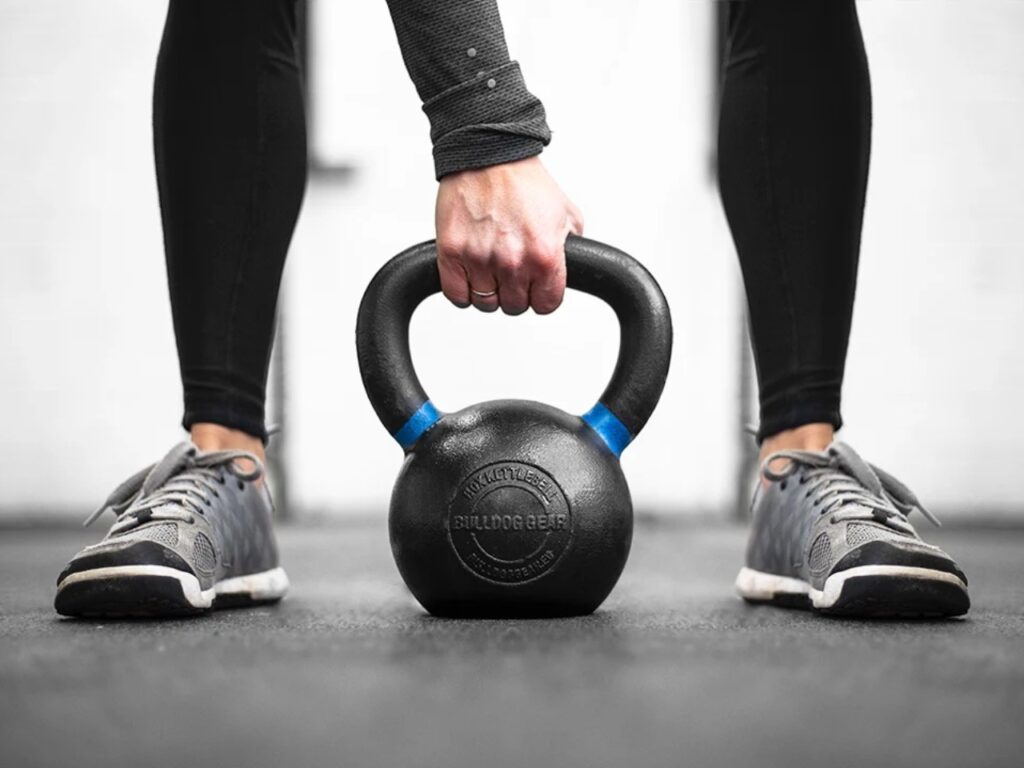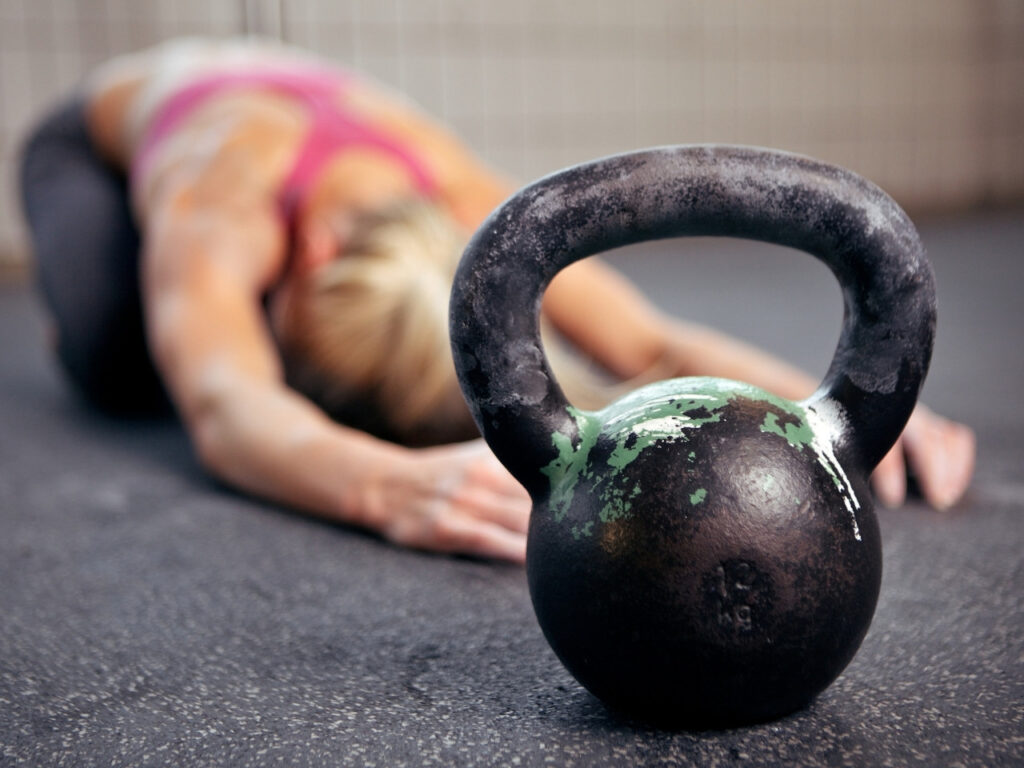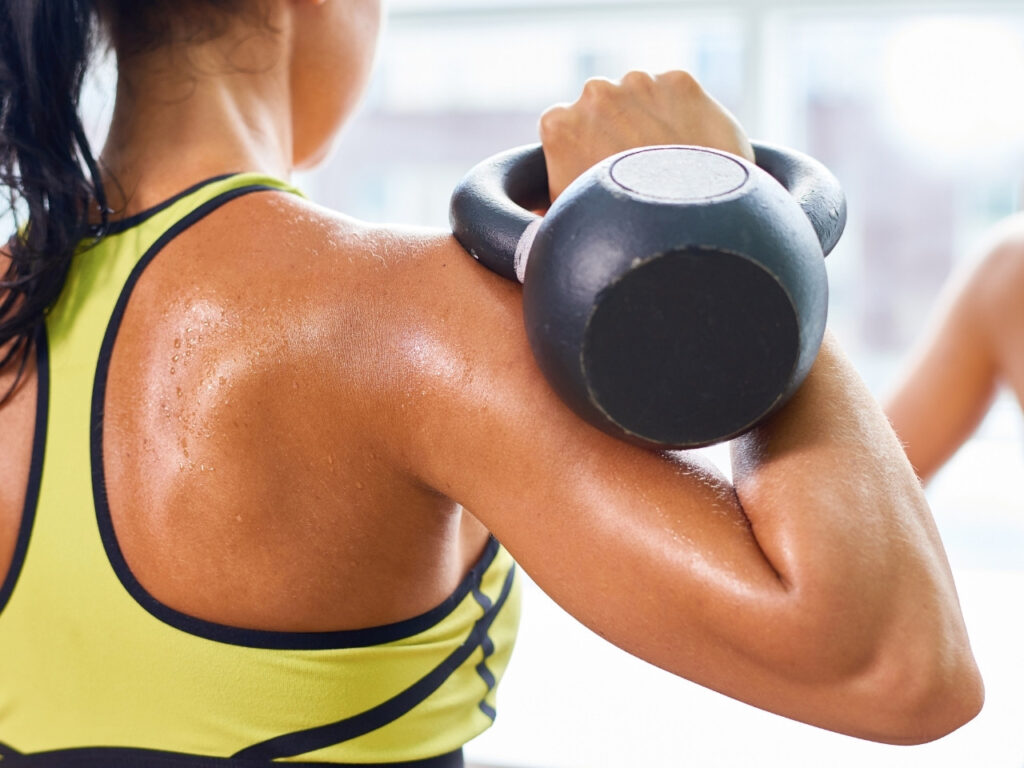If you’re in your 40s and feeling like your body’s changing in ways you don’t quite recognise – you’re not alone. From creeping weight gain and softening muscle tone to unexpected aches and dips in energy, midlife can feel like a turning point. But it’s not the beginning of the end – it’s the beginning of your next chapter. And kettlebell strength training could be one of the most powerful tools for supporting women’s health in their 40s and beyond.
In this article, you’ll learn why kettlebell training is the smartest, simplest way to build strength in your 40s and beyond, supporting everything from bone health to metabolism, functional fitness and hormone balance. Whether you’re brand new to strength training or ready to switch things up, this is for you.

Why Your Body Changes in Your 40s
Your 40s can feel like your body is rewriting the rules – and in many ways, it is. The hormonal shifts of perimenopause affect everything from where you store fat to how your body builds and maintains muscle and bone. Oestrogen levels start to fluctuate and gradually decline, which impacts key systems that previously worked in your favour.
One of the biggest changes is a natural loss of muscle mass, known as sarcopenia. This gradual decline begins around the age of 30, but accelerates in midlife – making it easier to lose strength and harder to maintain tone. Less muscle also means a slower metabolism, which contributes to fat gain, particularly around the middle.
Alongside this, women become more prone to storing fat around the belly due to hormonal shifts and insulin resistance – even if your eating habits haven’t changed. Read more about weight gain and belly fat in perimenopause.
And it’s not just muscle. Bone density also begins to decline as oestrogen drops, increasing the risk of osteoporosis. The years leading up to menopause are when bone loss happens most rapidly, yet many women aren’t aware of it until it becomes a problem.
All of this makes strength training, not just cardio, absolutely essential in your 40s and beyond.
Bone Density – A Midlife Wake-Up Call
Your 40s are a critical time for protecting your bones – even if you feel strong and healthy now. As oestrogen levels decline during perimenopause, the natural process of bone turnover starts to favour breakdown over rebuilding. In fact, women can lose up to 10% of their bone density in the years surrounding menopause, often without realising it.
This matters because osteoporosis doesn’t happen overnight – it’s the result of years of silent loss. And while calcium, vitamin D and nutrition all play a role, strength training is one of the most powerful ways to support bone health. That’s because your bones respond to load. When muscles pull on bones during resistance-based movement, it stimulates bone-building cells, helping to maintain (and even increase) density.
Weight-bearing exercise is essential, but not all forms are equal. Kettlebell training combines strength and impact in a controlled, joint-friendly way, making it an ideal choice for women who want to protect their bones without pounding their joints.
By prioritising strength now, you’re not only protecting your future – you’re building a foundation of resilience and confidence for the years ahead.
Why Strength Training is Non-Negotiable After 40
If there’s one form of exercise that every woman over 40 should prioritise, it’s strength training. This isn’t about lifting heavy weights in a gym or building bulky muscle – it’s about preserving the muscle you naturally lose, protecting your bones, and supporting long-term health and vitality.
By midlife, most women have already started to experience age-related muscle loss (sarcopenia) and bone density decline – both of which accelerate during perimenopause. Without resistance-based movement, these losses continue unchecked, making you more prone to injury, fatigue, poor posture and metabolic slowdown.
Strength training works because it actively signals to your body to hold on to lean muscle and bone. It improves body composition, helps stabilise blood sugar, supports hormone balance, and boosts confidence and energy levels.
And unlike cardio, which can burn muscle if overdone, strength training builds and preserves it – making it one of the most effective ways to maintain a healthy weight and feel strong, capable and in control of your body.
Whether you’re lifting kettlebells, resistance bands, or even your own bodyweight – strength training is not a nice-to-have. It’s a must.
Why Functional Strength & Mobility Matter Now
Strength isn’t just about lifting weights – it’s about living well. Functional strength means having the physical capacity to move through daily life with ease, from carrying shopping bags and lifting children to getting up off the floor or navigating stairs without strain.
As we age, mobility and strength naturally decline, especially without targeted training. That’s why it’s so important to build not just raw strength, but strength you can use – in ways that support balance, posture, coordination and injury prevention.
Kettlebell training shines here because it’s dynamic, full-body and functional. Movements like swings, presses and squats mirror real-life actions, challenging multiple muscle groups at once while also improving core stability and joint mobility.
The result? A stronger, more capable body that moves well – and keeps moving well – long into your 50s, 60s and beyond.
What Are Kettlebells?
Kettlebells are a type of free weight shaped like a cannonball with a handle. Originally used in Russian strength training, they’ve gained popularity for their versatility, effectiveness and space-saving design – making them ideal for home workouts.
What sets kettlebells apart from dumbbells or machines is their off-centre weight. This challenges your body to stabilise and control each movement, engaging more muscles – especially through your core – with every rep. Most kettlebell exercises are compound movements, meaning they work multiple muscle groups at once.
From squats and swings to presses and pulls, kettlebells offer a dynamic, functional approach to building strength, balance and coordination – with just one piece of equipment.

11 Benefits of Kettlebell Training for Women Over 40
Kettlebell training isn’t just effective, it’s smart, efficient and perfectly suited to the needs of midlife women. Here’s why it deserves a place in your weekly routine:
1. Builds Lean Muscle
Strengthens major muscle groups to combat age-related muscle loss (sarcopenia) and improve body composition.
2. Supports Bone Health
The resistance and impact from kettlebell movements help stimulate bone-building cells, reducing the risk of osteoporosis.
3. Boosts Metabolism
More muscle = higher resting metabolic rate. Kettlebell training helps support a healthy weight without excessive cardio.
4. Improves Core Strength
The off-centre load naturally recruits your core with every movement, supporting posture, stability and back health.
5. Increases Functional Fitness
Mimics real-life movements – lifting, reaching, bending – helping you move better in daily life, not just in the gym.
6. Improves Mobility
Strengthens through a full range of motion, maintaining joint health, flexibility and freedom of movement as you age.
7. Enhances Balance and Coordination
Strengthens the small stabilising muscles that support joints and reduce your risk of falls or injury.
8. Supports Hormonal Health
Strength training helps regulate blood sugar, reduce stress, and support a more balanced hormonal environment.
9. Builds Confidence and Resilience
Feeling physically strong impacts your mindset. Kettlebell training helps you feel more in control of your body.
10. Saves Time
Kettlebell workouts combine strength and cardio in one – ideal if you’re busy but want real results.
11. You Can Do It at Home
All you need is one kettlebell and a bit of space – no gym required. It’s a low-barrier, high-impact workout.
How to Start Strength Training with Kettlebells
The beauty of kettlebells is how accessible they are – even if you’ve never lifted a weight before. You don’t need a gym membership, a complicated plan or a background in fitness. What you do need is the right guidance and a safe, structured approach.
If you’re new to kettlebell training, start with a light to moderate weight (usually 6–8kg is ideal for beginners) and focus on learning the foundations – proper form, breathing, and movement patterns. The goal isn’t to go heavy or fast, but to build strength steadily and sustainably.
It’s normal to feel unsure in the beginning – but you don’t have to do it alone.
A Strength Training Approach Designed for Midlife Women
Rebells is the kettlebell strength training programme inside Menopause.Rescripted, created specifically for women in midlife. It’s designed to help you build strength, mobility and confidence – at your own pace, in your own space.
Inside Rebells, you’ll get:
- Expert-led, whole-body kettlebell sessions, three times a week
- Clear video tutorials that break down each move
- Progressive kettlebell programmes you can follow at your own pace
- A supportive community that gets it – and gets you
Whether you’re just getting started, coming back to movement after a break, or already regularly strength training, Rebells gives you everything you need to feel stronger, fitter and more in control of your body.
Join Menopause.Rescripted to get started with Rebells today
You Deserve to Feel Strong
Strength training in your 40s and beyond isn’t about chasing perfection – it’s about building resilience, confidence and the kind of energy that carries you through life feeling strong. Kettlebells offer a simple, effective and empowering way to do just that. Your body is changing, but with the right approach, it can change for the better.

Kettlebell FAQs
Absolutely. Kettlebell training is one of the most effective ways for women in their 40s and beyond to build strength, support bone health, improve mobility and boost confidence. It’s low-impact but high-result — ideal for midlife bodies.
Yes — but not in isolation. Kettlebell workouts build muscle, improve insulin sensitivity and increase overall energy expenditure, which can support fat loss, especially around the middle. When combined with a balanced, protein-rich diet, they’re incredibly effective.
Most beginners start with a 6–8kg kettlebell for basic movements like deadlifts and squats. If you’re new to strength training, it’s better to go lighter and focus on good form, then build up as you grow stronger. In Rebells, we guide you every step of the way.
They can be — especially during movements like cleans and snatches if technique is off. But this can be avoided by using proper form, choosing an appropriate weight, and starting with simpler moves. A soft wrist wrap or sweatband can also help if you’re concerned.
If you’re just getting started, wrist guards or soft sweatbands can offer comfort while your wrists adapt. Gloves are less commonly used because they can interfere with grip. Most women find they don’t need them long term once technique improves.
Yes — especially when you’re training consistently. A well-structured 20–30 minute kettlebell session that targets the whole body is enough to build muscle, improve mobility and boost metabolism. Consistency matters more than duration.